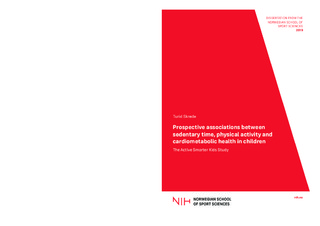| dc.contributor.author | Skrede, Turid | |
| dc.date.accessioned | 2019-04-10T11:44:38Z | |
| dc.date.available | 2019-04-10T11:44:38Z | |
| dc.date.issued | 2019 | |
| dc.identifier.isbn | 978-82-502-0569-7 | |
| dc.identifier.uri | http://hdl.handle.net/11250/2594047 | |
| dc.description | Avhandling (doktorgrad) - Norges idrettshøgskole, 2019 | nb_NO |
| dc.description.abstract | Background: A large proportion of children and adolescents are not sufficiently active according to PA recommendations. Cross-sectional studies find low PA levels to be associated with excessive body weight and poor cardiometabolic health in apparently healthy children, but sedentary time is also suggested as a risk factor for these outcomes.
Main aim: To systematically review and examine the prospective associations between objectively measured sedentary time and intensity-specific PA with cardiometabolic health indicators and adiposity in youth.
Materials and methods: First, a systematic review and meta-analysis were performed to assess the knowledge gaps in the current literature. Three original studies used data from the Active Smarter Kids (ASK) Study, a cluster-randomised school-based PA intervention, conducted in 2014-15 amongst 1180 children aged 10 years old at baseline, in Western Norway. At baseline and follow-up the following health-related variables were assessed; PA were measured by accelerometry (GT3X/GT3X+), and an intermittent running test (the Andersen-test) estimated VO2peak and were used as a measure of CRF. Cardiometabolic outcomes were anthropometry (body mass index (BMI), waist circumference (WC) and sum of four skinfolds), blood samples (low-density lipoprotein cholesterol, high-density lipoprotein cholesterol, triglycerides, glucose and insulin), and blood pressure. The meta-analysis for MVPA and clustering of cardiometabolic risk factors were conducted using random effects models with unstandardized regression coefficients and 95% confidence intervals. Statistical analyses of ASK Study data were performed by linear mixed modelling with schools as random intercept to account for clustering within data, and adjustments by age, sex, socio-economic status, puberty, and baseline value of the outcome.
Results: Based on the systematic review, we found no evidence for a prospective association between sedentary time and cardiometabolic risk factors in youth, while the evidence for a prospective association between MVPA and clustering of cardiometabolic risk factors is consistent and inverse, supported by our meta-analysis (Study I). These observations also corroborated with results based on ASK Study data (Study II). Moreover, CRF is a moderator in the prospective association between PA and the clustered cardiometabolic risk; the association between MVPA and clustered cardiometabolic risk was stronger in children with low CRF, and no associations appeared present in their high fit peers (Study III). In bi-directional analyses, time spent sedentary do not predict any adiposity measures, while MVPA and VPA predicts lower skinfolds (Study IV). On the contrary, baseline BMI, WC and skinfolds predicts more time spent sedentary, and less PA, MVPA and VPA but mainly in boys.
Conclusion: Apparently, as long as youth spend sufficient time in MVPA, being sedentary causes little harm to cardiometabolic health and do not predict adiposity. Spending time in MVPA might be especially important for children with low CRF. On the contrary, as adiposity predicts higher sedentary time and less PA over a short time period, highlights the crucial role of PA prevention before excess adiposity are established. | nb_NO |
| dc.description.abstract | Paper I: Skrede, T., Steene-Johannessen, J., Anderssen, S.A., Resaland, G.K., & Ekelund, U. The prospective association between objectively measured sedentary time, moderate-tovigorous physical activity and cardiometabolic risk factors in youth: a systematic review and meta-analysis. (Revised and resubmitted July 2018 to Obesity Reviews) | nb_NO |
| dc.description.abstract | Paper II: Skrede, T., Stavnsbo, M., Aadland, E., Aadland, K. N., Anderssen, S. A., Resaland, G. K., & Ekelund, U. (2017). Moderate-to-vigorous physical activity, but not sedentary time, predicts changes in cardiometabolic risk factors in 10-y-old children: the Active Smarter Kids Study. Am J Clin Nutr, 105(6), 1391-1398. Doi: 10.3945/ajcn.116.150540 | nb_NO |
| dc.description.abstract | Paper III: Skrede, T., Aadland, E., Andersen, L.B., Stavnsbo, M., Anderssen, S.A., Resaland, G.K., & Ekelund, U. (2018). Does cardiorespiratory fitness moderate the prospective association between physical activity and cardiometabolic risk factors in children? Int J Obes, 42(5), 1029-1038. Doi: 10.1038/s41366-018-0108-z. | nb_NO |
| dc.description.abstract | Paper IV: Skrede, T., Aadland, E., Anderssen, S.A., Resaland, G.K., & Ekelund U. (2018). Bidirectional prospective associations between objectively measured sedentary time, physical activity and adiposity in 10-year-old children. (Submitted) | nb_NO |
| dc.language.iso | eng | nb_NO |
| dc.subject | nih | nb_NO |
| dc.subject | doktoravhandling | nb_NO |
| dc.subject | fysisk aktivitet | |
| dc.subject | inaktivitet | |
| dc.subject | kardiometabolsk helse | |
| dc.subject | bidireksjonal | |
| dc.subject | overvektig | |
| dc.subject | stillesittende | |
| dc.subject | fysisk aktivitet | |
| dc.subject | trim | |
| dc.subject | helse | |
| dc.subject | motivasjon | |
| dc.subject | bedrifter | |
| dc.subject | arbeidsmiljø | |
| dc.subject | forebygging | |
| dc.subject | treningseffekt | |
| dc.title | Prospective associations between sedentary time, physical activity and cardiometabolic health in children: The Active Smarter Kids Study | nb_NO |
| dc.type | Doctoral thesis | nb_NO |
| dc.description.localcode | Seksjon for idrettsmedisinske fag / Department of Sports Medicine | nb_NO |
